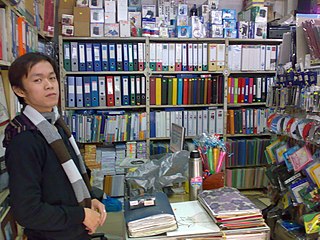
Office supplies are consumables and equipment regularly used in offices by businesses and other organizations, by individuals engaged in written communications, recordkeeping or bookkeeping, janitorial and cleaning, and for storage of supplies or data. The range of items classified as office supplies varies, and typically includes small, expendable, daily use items, consumable products, small machines, higher cost equipment such as computers, as well as office furniture and art.
SEMI is an industry association comprising companies involved in the electronics design and manufacturing supply chain. They provide equipment, materials and services for the manufacture of semiconductors, photovoltaic panels, LED and flat panel displays, micro-electromechanical systems (MEMS), printed and flexible electronics, and related micro and nano-technologies.
Zodiac Aerospace was a French aerospace group, active from 1896 to 2018, that supplied systems and equipment for aircraft. In October 2018, it was acquired by French aerospace and defense company Safran.

NOV Inc., formerly National Oilwell Varco, is an American multinational corporation based in Houston, Texas. It is a worldwide provider of equipment and components used in oil and gas drilling and production operations, oilfield services, and supply chain integration services to the upstream oil and gas industry. The company conducts operations in more than 500 locations across six continents, operating through two reporting segments: Energy Equipment and Energy Products and Services.
Doosan Enerbility Co., Ltd., formerly known as Doosan Heavy Industries, is a heavy industrial company headquartered in Changwon, South Korea. It was established in 1962. Its business includes manufacturing and construction of nuclear power plants, thermal power stations, turbines and generators, desalination plants, castings, and forgings.

Genuine Parts Company (GPC) is an American company engaged in the distribution of automotive replacement parts, industrial replacement parts, office products and electrical/electronic materials. GPC serves numerous customers from more than 2,600 operations around the world, and has approximately 48,000 employees. It owns the NAPA Auto Parts brand.
Molten Corporation is a sports equipment and automotive parts company based in Hiroshima, Japan.

The Kellogg Switchboard and Supply Company was an American manufacturer of telecommunication equipment. Anticipating the expiration of the earliest, fundamental Bell System patents, Milo G. Kellogg, an electrical engineer, founded the company in 1897 in Chicago to produce telephone exchange equipment and telephone apparatus.

UNIFE, or the European Rail Supply Industry Association, is an association of Europe's rail supply companies active in the design, manufacture, maintenance and refurbishment of rail transport systems, subsystems and related equipment. UNIFE also brings together 15 national rail industry associations of European countries. UNIFE is a member of the Group of Representative Bodies.

Equipment rental, or plant hire, is a service industry providing machinery, equipment and tools for a limited period of time to final users, mainly to construction contractors but also to industry and individual consumers. Renting can be defined as paying someone for the use of something for temporary or short-term purposes.
This article lists rankings of semiconductor equipment suppliers by sales.

A-dec is a dental office furniture and equipment manufacturer based in Newberg, Oregon, United States. It is considered one of the largest dental equipment makers in the world, and as of 2002 is Newberg's largest employer with 832 employees. Founded in 1964, the company's annual revenue of $250 million comes from the sale of products such as dental chairs, stools, delivery systems, medical lighting, cabinetry, and other accessories.

Diving equipment, or underwater diving equipment, is equipment used by underwater divers to make diving activities possible, easier, safer and/or more comfortable. This may be equipment primarily intended for this purpose, or equipment intended for other purposes which is found to be suitable for diving use.
Dentsply Sirona Inc. is an American dental equipment manufacturer and dental consumables producer that markets its products in over 120 countries. It has factories in 21 countries. The present company is largely the result of a merger in 1993 in which Gendex Corporation acquired Dentsply International Inc. for $590 million.
Webb Ellis Limited is a British manufacturing company based in London. The company, focused on rugby union and netball, manufactures a wide range of sports equipment, including sportswear, rugby union balls, protective gear, and accessories.
Interserve Rail is a British engineering and facilities management company. Founded in 1910, it is a subsidiary of Interserve.

The history of scuba diving is closely linked with the history of the equipment. By the turn of the twentieth century, two basic architectures for underwater breathing apparatus had been pioneered; open-circuit surface supplied equipment where the diver's exhaled gas is vented directly into the water, and closed-circuit breathing apparatus where the diver's carbon dioxide is filtered from the exhaled breathing gas, which is then recirculated, and more gas added to replenish the oxygen content. Closed circuit equipment was more easily adapted to scuba in the absence of reliable, portable, and economical high pressure gas storage vessels. By the mid-twentieth century, high pressure cylinders were available and two systems for scuba had emerged: open-circuit scuba where the diver's exhaled breath is vented directly into the water, and closed-circuit scuba where the carbon dioxide is removed from the diver's exhaled breath which has oxygen added and is recirculated. Oxygen rebreathers are severely depth limited due to oxygen toxicity risk, which increases with depth, and the available systems for mixed gas rebreathers were fairly bulky and designed for use with diving helmets. The first commercially practical scuba rebreather was designed and built by the diving engineer Henry Fleuss in 1878, while working for Siebe Gorman in London. His self contained breathing apparatus consisted of a rubber mask connected to a breathing bag, with an estimated 50–60% oxygen supplied from a copper tank and carbon dioxide scrubbed by passing it through a bundle of rope yarn soaked in a solution of caustic potash. During the 1930s and all through World War II, the British, Italians and Germans developed and extensively used oxygen rebreathers to equip the first frogmen. In the U.S. Major Christian J. Lambertsen invented a free-swimming oxygen rebreather. In 1952 he patented a modification of his apparatus, this time named SCUBA, an acronym for "self-contained underwater breathing apparatus," which became the generic English word for autonomous breathing equipment for diving, and later for the activity using the equipment. After World War II, military frogmen continued to use rebreathers since they do not make bubbles which would give away the presence of the divers. The high percentage of oxygen used by these early rebreather systems limited the depth at which they could be used due to the risk of convulsions caused by acute oxygen toxicity.

Sport-Saller is a German sports equipment mail order company which focuses on association football products. The company was established in 1972 and is based in Weikersheim, Baden-Württemberg.
Tejas Networks is an optical, broadband and data networking products company based in India. The company designs develops and sells its products to telecom service providers, internet service providers, utilities, security and government entities in 75 countries. The company has built many IPs in multiple areas of telecom networking and has emerged as an exporter to other developing countries including Southeast Asia and Africa.









